 IBM recently announced the addition of a Brocade Fibre Channel over Ethernet (FCoE) switch module for the IBM BladeCenter designed to deliver up to 24% savings over traditional 10Gb Ethernet & 8Gb FC setup.
IBM recently announced the addition of a Brocade Fibre Channel over Ethernet (FCoE) switch module for the IBM BladeCenter designed to deliver up to 24% savings over traditional 10Gb Ethernet & 8Gb FC setup.
Tag Archives: IBM BladeCenter
New IBM Blade Chassis? New Liquid Cooled Blade?
Okay, I’ll be the first to admit. I’m a geek. I’m not an uber-geek, but I’m a geek. When things get slow, I like digging around in the U.S. Patent Archives for hints as to what might be coming next in the blade server market place. My latest find uncovered a couple of “interesting” patents that were published by the International Business Machines Corporation, also known as IBM.
Liquid Cooled Blades?
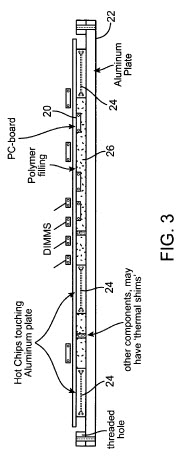 United States Patent #7552758, titled “Method for high-density packaging and cooling of high-powered compute and storage server blades” (published 6/29/2009) may be IBM’s clever way of disguising a method to liquid cool blade servers.
United States Patent #7552758, titled “Method for high-density packaging and cooling of high-powered compute and storage server blades” (published 6/29/2009) may be IBM’s clever way of disguising a method to liquid cool blade servers. According to the patent, the invention is “A system for removing heat from server blades, comprising: a server rack enclosure, the server rack enclosure enclosing: a liquid distribution manifold; a plurality of cold blades attached to the liquid distribution manifold, wherein liquid is circulated through the liquid distribution manifold and the cold blades; and at least one server blade attached to each of the cold blades, wherein the server blade includes a base portion, the base portion is a heat-conducting aluminum plate, the base portion is positioned directly onto the cold blade, and contact blocks penetrate the aluminum plate and make contact with corresponding contact points of the cold blades.”
According to the patent, the invention is “A system for removing heat from server blades, comprising: a server rack enclosure, the server rack enclosure enclosing: a liquid distribution manifold; a plurality of cold blades attached to the liquid distribution manifold, wherein liquid is circulated through the liquid distribution manifold and the cold blades; and at least one server blade attached to each of the cold blades, wherein the server blade includes a base portion, the base portion is a heat-conducting aluminum plate, the base portion is positioned directly onto the cold blade, and contact blocks penetrate the aluminum plate and make contact with corresponding contact points of the cold blades.”
You can read more about this patent, in detail, at http://www.freepatentsonline.com/7552758.html
New Storage Blade?
Another search revealed a patent for a “hard disk enclosure blade” (patent # 7499271), published on 3/3/2009, is a design that IBM seems to have been working on for a few years, as this design stems back to 2006.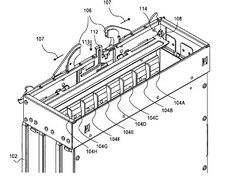 It appears to be a “double-wide” enclosure that will allow for 8 disk drives to be inserted.
It appears to be a “double-wide” enclosure that will allow for 8 disk drives to be inserted.
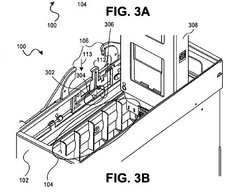
This is an interesting idea, if the goal were to be used inside a normal bladecenter chassis. It would be like having the local space of an IBM BladeCenter S, but in the IBM BladeCenter E or IBM BladeCenter H. On the other hand, it could have been the invention that was used for the storage modules of the IBM BladeCenter S. You can read more about this invention at http://www.freepatentsonline.com/7499271.html.
New IBM BladeCenter Chassis?
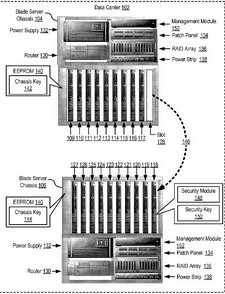 The final invention that I uncovered is very mysterious to me. Titled, “Securing Blade Servers in a Data Center,” patent application # 20100024001 shows a new concept from IBM encompassing a blade server chassis, a router, a patch panel, a RAID Array, a power strip and blade servers all inside of a single enclosure, or “Data Center.” An important note is that this device is not yet approved as a patent – it’s still a patent application. Filed on 7/25/2008 and published as a patent application on 1/28/2010, this patent application lists an abstract description of, “Securing blade servers in a data center, the data center including a plurality of blade servers installed in a plurality of blade server chassis, the blade servers and chassis connected for data communications to a management module, each blade server chassis including a chassis key, where securing blade servers includes: prior to enabling user-level operation of the blade server, receiving, by a security module, from the management module, a chassis key for the blade server chassis in which the blade server is installed; determining, by the security module, whether the chassis key matches a security key stored on the blade server; if the chassis key matches the security key, enabling, by the security module, user-level operation of the blade server; and if the chassis key does not match the security key, disabling, by the security module, operation of the blade server.” I’ve tried a few times to decipher what this patent is really for, but I’ve not had any luck. I encourage you to head over to http://www.freepatentsonline.com/y2010/0024001.html and take a look. If it makes sense to you, leave me a comment.
The final invention that I uncovered is very mysterious to me. Titled, “Securing Blade Servers in a Data Center,” patent application # 20100024001 shows a new concept from IBM encompassing a blade server chassis, a router, a patch panel, a RAID Array, a power strip and blade servers all inside of a single enclosure, or “Data Center.” An important note is that this device is not yet approved as a patent – it’s still a patent application. Filed on 7/25/2008 and published as a patent application on 1/28/2010, this patent application lists an abstract description of, “Securing blade servers in a data center, the data center including a plurality of blade servers installed in a plurality of blade server chassis, the blade servers and chassis connected for data communications to a management module, each blade server chassis including a chassis key, where securing blade servers includes: prior to enabling user-level operation of the blade server, receiving, by a security module, from the management module, a chassis key for the blade server chassis in which the blade server is installed; determining, by the security module, whether the chassis key matches a security key stored on the blade server; if the chassis key matches the security key, enabling, by the security module, user-level operation of the blade server; and if the chassis key does not match the security key, disabling, by the security module, operation of the blade server.” I’ve tried a few times to decipher what this patent is really for, but I’ve not had any luck. I encourage you to head over to http://www.freepatentsonline.com/y2010/0024001.html and take a look. If it makes sense to you, leave me a comment.
While this was nothing but a trivial attempt at finding the next big thing before it’s announced, I walk away from this amazed at the number of patents that IBM has, just for blade servers. I hope to do a similar exercise for HP, Dell and Cisco in the near future, after tomorrow’s Westmere announcements.
HP BladeSystem Rumours
I’ve recently posted some rumours about IBM’s upcoming announcements in their blade server line, now it is time to let you know some rumours I’m hearing about HP. NOTE: this is purely speculation, I have no definitive information from HP so this may be false info. That being said – here we go:
Rumour #1: Integration of “CNA” like devices on the motherboard.
As you may be aware, with the introduction of the “G6”, or Generation 6, of HP’s blade servers, HP added “FlexNICs” onto the servers’ motherboards instead of the 2 x 1Gb NICs that are standard on most of the competition’s blades. FlexNICs allow for the user to carve up a 10Gb NIC into 4 virtual NICs when using the Flex-10 Modules inside the chassis. (For a detailed description of Flex-10 technology, check out this HP video.) The idea behind Flex-10 is that you have 10Gb connectivity that allows you to do more with fewer NICs.
SO – what’s next? Rumour has it that the “G7” servers, expected to be announced on March 16, will have an integrated CNA or Converged Network Adapter. With a CNA on the motherboard, both the ethernet and the fibre traffic will have a single integrated device to travel over. This is a VERY cool idea because this announcement could lead to a blade server that can eliminate the additional daughter card or mezzanine expansion slots therefore freeing up valueable real estate for newer Intel CPU architecture.
Rumour #2: Next generation Flex-10 Modules will separate Fibre and Network traffic.
Today, HP’s Flex-10 ONLY allows handles Ethernet traffic. There is no support for FCoE (Fibre Channel over Ethernet) so if you have a Fibre network, then you’ll also have to add a Fibre Switch into your BladeSystem chassis design. If HP does put in a CNA onto their next generation blade servers that carry Fibre and Ethernet traffic, wouldn’t it make sense there would need to be a module that would fit in the BladeSystem chassis that would allow for the storage and Ethernet traffic to exit? 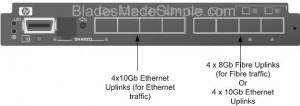
I’m hearing that a new version of the Flex-10 Module is coming, very soon, that will allow for the Ethernet AND the Fibre traffic to exit out the switch. (The image to the right shows what it could look like.) The switch would allow for 4 of the uplink ports to go to the Ethernet fabric and the other 4 ports of the 8 port Next Generation Flex-10 switch to either be dedicated to a Fibre fabric OR used for additional 4 ports to the Ethernet fabric.
If this rumour is accurate, it could shake up things in the blade server world. Cisco UCS uses 10Gb Data Center Ethernet (Ethernet plus FCoE); IBM BladeCenter has the ability to do a 10Gb plus Fibre switch fabric (like HP) or it can use a 10Gb Enhanced Ethernet plus FCoE (like Cisco) however no one currently has a device to split the Ethernet and Fibre traffic at the blade chassis. If this rumour is true, then we should see it announced around the same time as the G7 blade server (March 16).
That’s all for now. As I come across more rumours, or information about new announcements, I’ll let you know.
IBM Helps Use Blade Servers to Fight Fires
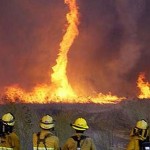 On Thursday, IBM plans to announce its work with university researchers to instantly process data for wildfire prediction — changing the delay time from every six hours to real-time. This will not only help firefighters control the blaze more efficiently, but deliver more informed decisions on public evacuations and health warnings.
On Thursday, IBM plans to announce its work with university researchers to instantly process data for wildfire prediction — changing the delay time from every six hours to real-time. This will not only help firefighters control the blaze more efficiently, but deliver more informed decisions on public evacuations and health warnings.The new joint project with the University of Maryland, Baltimore County allows for researches to analyze smoke patterns during wildfires by instantly processing the massive amounts of data available from drone aircraft, high-resolution satellite imagery and air-quality sensors, to develop more effective models for smoke dissipation using a cluster of IBM BladeCenters and IBM InfoSphere Streamsanalytics. Today analysis of smoke patterns is limited to weather forecasting data, observations from front line workers and low resolution satellite imagery. This new ability will provide fire and public safety officials with a real-time assessment of smoke patterns during a fire, which will allow them to make more informed decisions on public evacuations and health warnings.
Researchers expect to have a prototype of this new system available by next year.